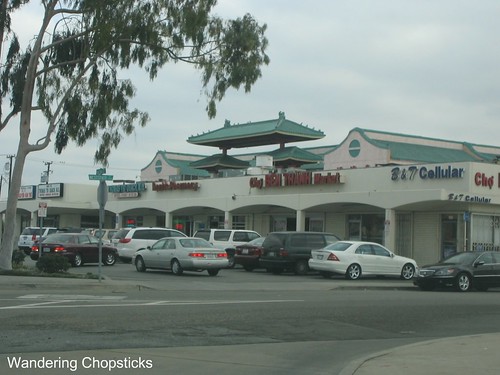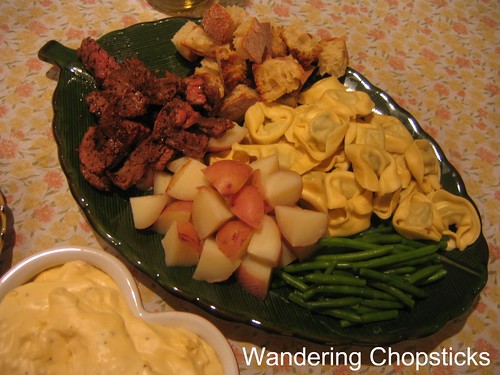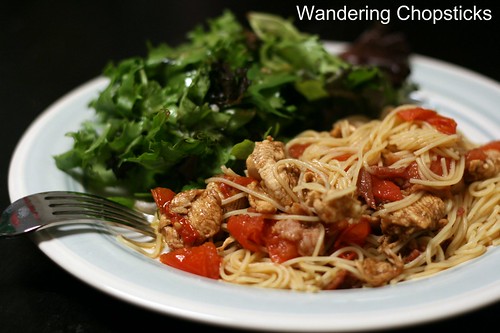It's hard to separate Little Saigon from its politics. Even when it comes to food.
And no review of Vien Dong Restaurant in Garden Grove is complete without mentioning its former owner, Tony Lam, the first Vietnamese American elected official.
Read more about him to read more about him, and read
my post about Little Saigon and its history to understand how volatile the Vietnamese American community can be.
The restaurant is now owned by Lam's niece. Back in its heyday, when Lam was on the Westminster City Council, the restaurant was filled with the movers and shakers of Little Saigon who were courting his attention. Lam would often go table to table to greet and chat with every customer.
Despite the lack of his presence now, Vien Dong still retains much of what originally drew customers to the restaurant. It's clean, the portions are large, and the prices are very reasonable. Most dishes are in the $5-$6 range, more for specialty items such as the
cha ca Thang Long (Vietnamese Hanoi-style turmeric sizzling fish with dill).
Vien Dong specializes in Northern Vietnamese cuisine. According to
Wikipedia, Northern Vietnamese food is more Chinese-influenced with many stir-fries, more soy sauce than fish sauce, black pepper instead of chili for spice, fewer vegetables, and more beef because of the influence from 13th century Mongolian invasions.
Now, I'm no food expert, I just like to eat. A lot. I read a lot too. And travel. So I'd have to disagree with almost all of the above. In
my previous discussion of Vietnamese food, I already admitted my preference for South-Central Vietnamese food. But I did eat my way around Hanoi for a full month. And in all honesty, except for
Cha Ca Thang Long (Vietnamese Hanoi-Style Turmeric Fish with Dill) and
bun cha, Northern food sadly pales in comparison to Central and Southern Vietnamese food. Yes, I think even
pho, which originated in the North, is much better down South. I didn't see more stir-fries up North than anywhere else in Vietnam. Since Saigon was settled by Ming dynasty generals and their troops fleeing the Manchus more than 300 years ago, and because there still is a
Cho Lon (big market), Saigon's Chinatown, I don't think the North has a monopoly on Chinese-influenced food in Vietnam. And if the food featured more soy sauce and black pepper, I sure didn't notice. There does tend to be less vegetables in the North but that's because of the colder climate and mountainous geography. In comparison, the South enjoys two rice harvests a year. And beef from Mongolian invasions? Like the constant rebellions against Chinese domination, the Vietnamese are also quite proud to have successfully fought off the Mongols. So there!
Now that's Vietnamese food in Vietnam. I've said before that I think Vietnamese food in America is much better because as a wealthier country, we can afford to splurge on ingredients. And with modern movements of people, regional cuisine don't necessarily stay regional.
Most Vietnamese Americans who originally hailed from the North, fled South when the country was divided in 1954. They brought their regional cooking with them, but were influenced by the South. For example,
pho, which originated in the North, usually just had beef, rice noodles, and onions or scallions. The way it's mostly served now with basil, sawtooth herb, and bean sprouts is a Southern adaptation. Southern
pho also has a much more flavorful broth.
All that excessive background information aside, Vien Dong Restaurant, which specializes in Northern Vietnamese cuisine, was my choice to meet several Orange County food bloggers earlier this month. Elmo of
Monster Munching and Chubbypanda, The Epicurious Wanderer, had professed wanting to try
bun oc (Vietnamese water snail rice vermicelli soup). We were joined by
Rasa Malaysia and Christian Z of
Orange County Mexican Restaurants.
Bun cha is one of the few dishes I actually enjoyed during my time in Hanoi. Grilled pork slices and patties swim in a light sweet fish sauce, topped with sliced pickled chayote squash and carrots. Vermicelli rice noodles and various herbs, including mint and cilantro, rounded out the meal. This dish has three variations, with one version including
cha gio (Vietnamese egg rolls). I would highly recommend ordering
bun cha with
cha gio if eating alone, but I was already ordering it as an appetizer.

Vien Dong offers some of the best
cha ca Thang Long in Little Saigon. (In the rest of the country,
cha (paste)
ca (fish) is literally a fish paste patty and is an entirely different dish.) Despite its name,
cha ca Thang Long is not actually fish paste. It's tilapia that's been seasoned with turmeric and comes on a sizzling platter with lots and lots of onions, scallions and dill. The use of dill is a distinctly Northern specialty as other regions of Vietnam don't cook with it at all. In Vietnam, the fish used in this dish is
ca loc (snakehead), but it's illegal in America because it is very invasive. And at Cha Ca La Vong in Hanoi, the restaurant that claims to have invented this dish several hundred years ago and where the street is named after this dish, the fish comes in chunks and sits in a saucepan with about half an inch of oil. You toss the dill and onions into the oil to wilt before eating.
Unfortunately, in my photo you can barely see the fish under the mound of herbs.

It comes with a side of more herbs, rice vermicelli noodles, fermented shrimp sauce, and toasted sesame rice paper. To eat, grab a little bit of everything into your bowl, and douse it with the smelly shrimp sauce. The blandness of the noodles, the crunch of the rice paper, the slight herbal notes of the turmeric in the fish, the refreshing dill, and the salty goodness of the shrimp sauce hit a little bit of everything on your taste buds.

Chubbypanda was on an
oc (snails) kick and ordered these steamed ground pork and
oc patties. I've always eaten
oc whole and was wary about the loss of flavor when mixed with so much pork, but the patties still tasted really
oc-y, if you know what I mean. These came with some gingered fish sauce for dipping, really necessary since
oc alone is rather boring and the ginger toned down the fishiness of the
oc.

Yes, yet another plate of herbs. Many Vietnamese have a plate of herbs on the table and simply tear off leaves and eat them with everything. I think this plate might have been intended for the
oc though.

Look at the golden flaky perfection of the
cha gio. You can tell these were wrapped in rice paper and not Chinese egg roll skins. Rice paper wrappers have a lighter, flakier outside layer, while the innermost layer retains a slight chewiness. Although, I was surprised the restaurant didn't call them
nem ran, which is what Northerners call
cha gio.

Here's the overview picture of everything we ordered.

This is
goi mit (Vietnamese green jackfruit salad) with slices of pork, shrimp, chayote squash, carrots, herbs, toasted peanuts, and toasted sesame rice paper. The salad is a little bland and I'd suggest dousing it with lots of fermented shrimp sauce for flavor. Can you spot the unripe jackfruit? It's the flesh-colored chunks on the bottom right corner of this picture.


Now comes the reason why I chose this restaurant. Elmo's first foray into bun rieu oc was disappointing and I had suggested he try Vien Dong's rendition. His verdict? "Truly the best
bun rieu oc that I've had (well, okay, I only had it once before), but that was exactly what I hoped
bun rieu would taste like. Couldn't get enough of those snails." So with an Elmo endorsement, do I really need to say more?
Bun rieu oc is a tomato-based rice vermicelli noodle soup with minced crab and shrimp patties, water snails, and fried tofu chunks. Vien Dong's version includes plenty of large
oc, but the patties are dispersed. Add plenty of fermented shrimp paste and you get a deeply savory broth. Many years ago, I brought two German professors, who were studying the Vietnamese American community, to dine here and they couldn't get enough of the broth and slurped their bowls clean.
Vien Dong's variations of this soup includes the options of shrimp only, crab only, both, and with or without water snails. The bowl of
bun rieu oc tom moc, with all of the above, is what you see pictured below.

Another Northern regional specialty that none of us ordered was
bun gia cay (fake dog noodle soup). Dog meat is eaten more in the North than the South. (Insert bad Asian stereotype jokes here.) The restaurant's fake dog noodle soup, which uses pork, is a curry-based broth.
Other food suggestions include the yam fries with shrimp, braised pork with hard-boiled eggs, and pork chops with rice. I'd avoid the
bun bung though. The description of noodle soup with pork spare ribs, plaintains, and tofu sounds tempting, but I've always been disappointed with its absolute blandness. Though Vien Dong specializes in Northern Vietnamese cuisine, there are plenty of other dishes to please your palate as well.
May 10, 2011 update: More dishes can be seen in my revisit here in my
Exploring Vietnamese Regional Cuisine, North, Central, and South, in Little Saigon post.
Vien Dong Restaurant
14271 Brookhurst St.
Garden Grove, CA 92843
714-531-8253
(In case you're interested, Vien Dong Restaurant is located around the corner from the Orange County Islamic Society. The mosque features a dome with separate worship halls for men and women. The building is not aligned with the street, but to face Mecca. There's a Halal meat grocery store at the other end of the strip mall from the restaurant. There are several other Muslim grocery stores along the Vietnamese-dominated businesses on Brookhurst Street.)
 Scrumptious aren't they? Too bad I can't digest fabric...
Scrumptious aren't they? Too bad I can't digest fabric...
















































